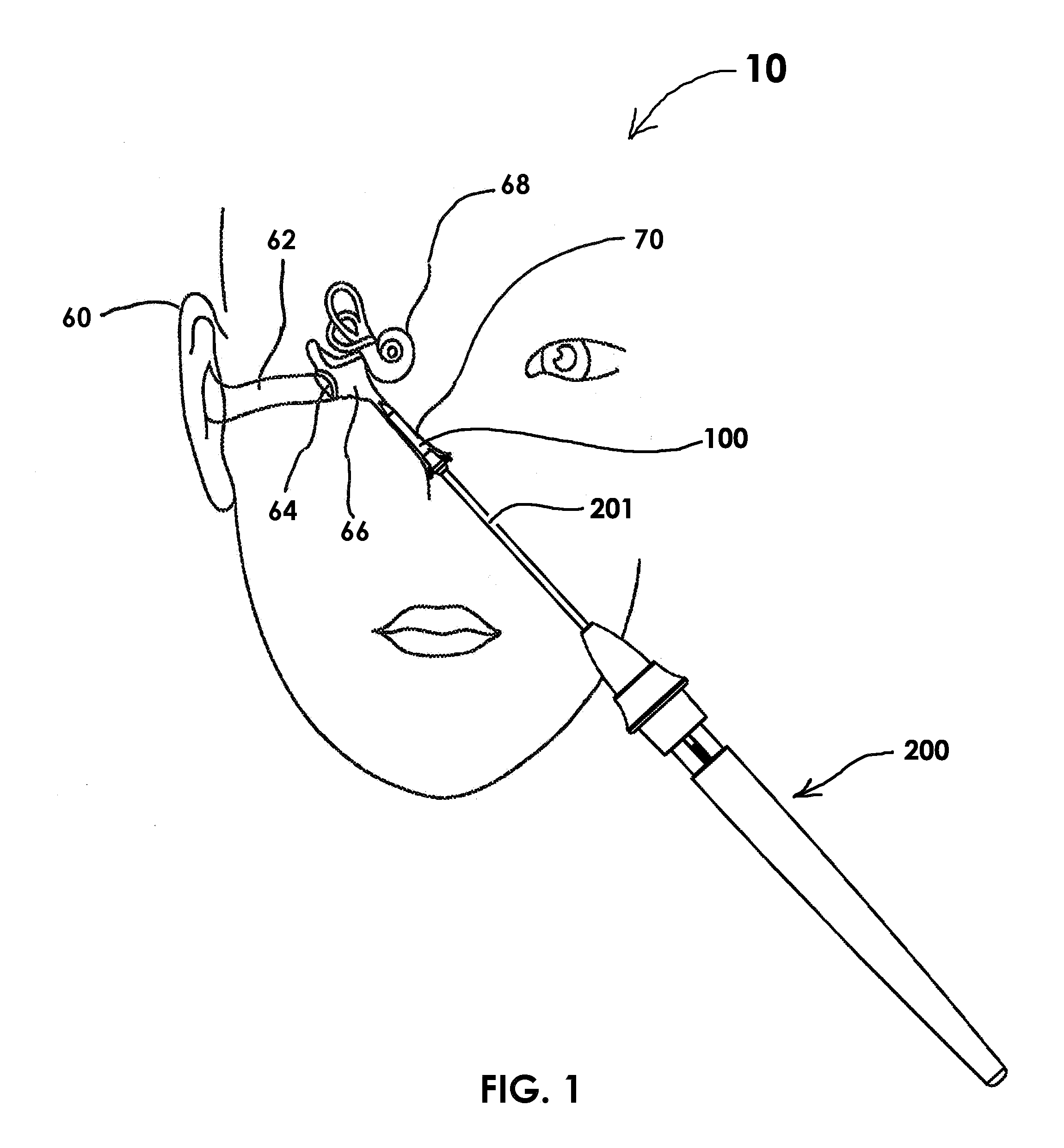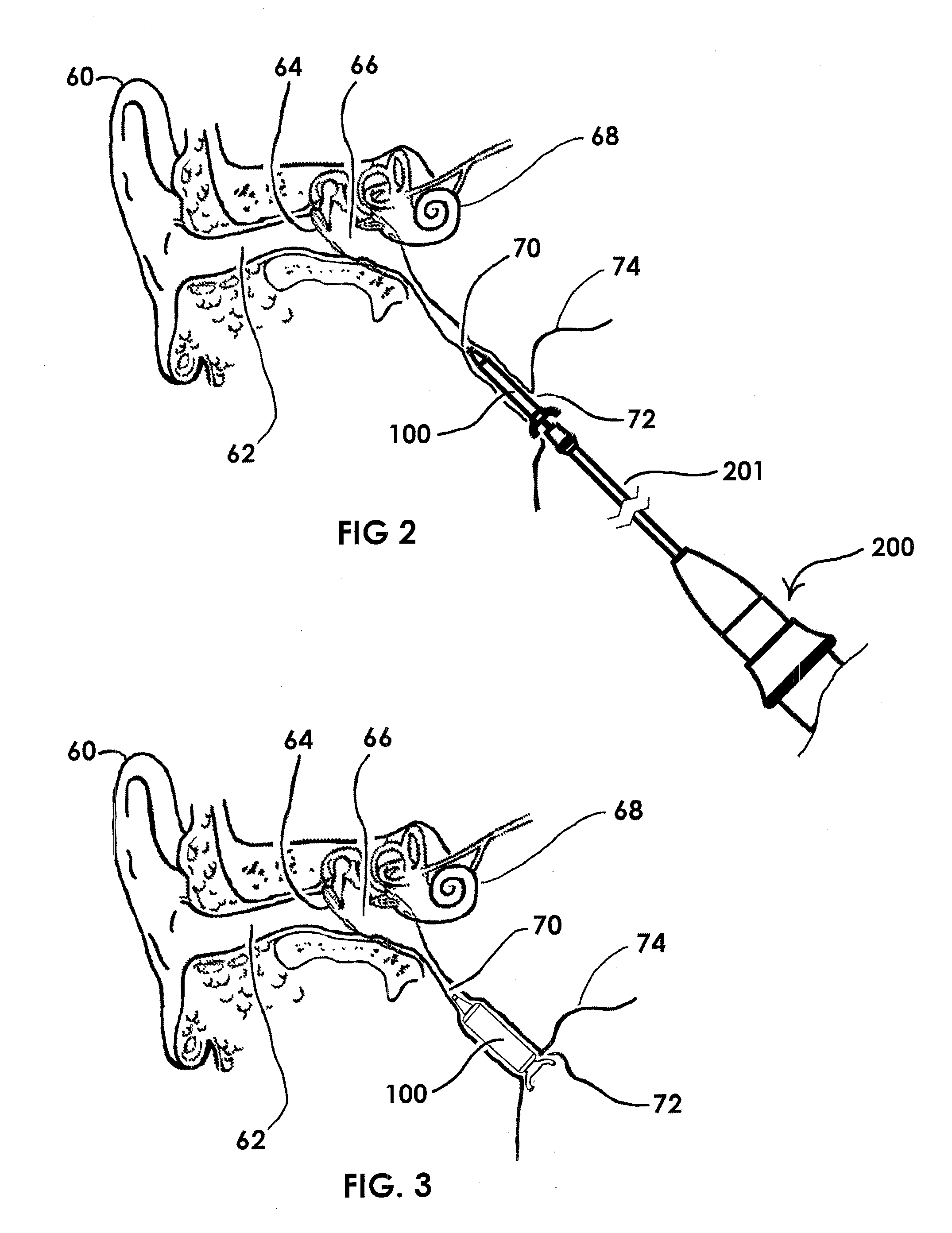Devices and methods for Dilating a Eustachian Tube
a technology of eustachian tubes and dilators, which is applied in the field of devices and methods for dilating eustachian tubes, can solve the problems of eustachian tube dysfunction, eustachian tube dysfunction is especially problematic, and the inner ear and mastoid air cell system is chronically infected and destroyed
- Summary
- Abstract
- Description
- Claims
- Application Information
AI Technical Summary
Benefits of technology
Problems solved by technology
Method used
Image
Examples
example 1
[0175]A bendable, osmotic dilation system for treating Eustachian tube dysfunction is fabricated. 304 stainless steel tubing having an outside diameter of 0.020 inch and inside diameter of 0.012 inch and wall thickness of 0.004 inch is cut to lengths of 20 mm. The tubing is supplied by Small Parts Incorporated, Logansport, Ind. Next, an extruded polyurethane tube having an outside diameter of 0.036 inch, inside diameter of 0.020 inch, and length of 14.4 mm is slipped onto the stainless steel tube and positioned on the tube such that 1.8 mm of bare metal is present at one end and 3.8 mm of bare metal is present at the opposite end. The polyurethane tube comprises a uniform blend of 9 parts Tecophilic HP93A-100 and 1 part polyvinyl pyrrolidone. The Tecophilic is supplied by Lubrizol, Wilmington, Mass., and the polyvinyl pyrrolidone is supplied as Kollidon 12PF by BASF Corporation, Ludwigshafen, West Germany. This completes subassembly of the flexible, subcoated tube.
[0176]An osmotic e...
example 2
[0185]A self-anchoring, flexible osmotic stent for treating Eustachian tube dysfunction is fabricated. A flexible polyimide tubing having an outside diameter of 0.020 inch, inside diameter of 0.014, and wall thickness of 0.003 inch is cut into lengths of 80 mm. The polyimide tubing is supplied by Small Parts Company, Plainsfield, Ill. An extrude tube comprising a polyurethane composition and having an inside diameter of 0.020 inch, outside diameter of 0.028 inch, and wall thickness of 0.004 inch is slipped over the polyimide tube. The polyurethane tube comprises 95 parts Tecophilic HP93A-100 and 5 parts polyvinyl pyrrolidone. The Tecophilic is supplied by Lubrizol, Wilmington, Mass., and the polyvinyl pyrrolidone is supplied as Kollidon 17PF by BASF Corporation, Ludwigshafen, West Germany. This completes subassembly of the flexible, subcoated tube.
[0186]A batch of osmotic engines is fabricated using the same composition and processing conditions as describe in Example 1. A batch of ...
example 3
[0190]A device for treating Eustachian tube dysfunction which device remains patent of mucous, water, blood, and aqueous fluids during operation is manufactured.
[0191]The device is fabricated according to the compositions and procedures described in Example 2 except that the polymer inner tube is polyimide that has a hydrophobic surface lining the lumen of the tube. When the device is in operation, aqueous body fluids do not wet the inner surface of the tube due to the hydrophilic nature of the surface. As a result, the polyimide tube remains substantially unobstructed during treatment such that air can freely pass through the center of the device and allow equilibration of air pressure between the inner ear and the nasal cavity.
PUM
 Login to View More
Login to View More Abstract
Description
Claims
Application Information
 Login to View More
Login to View More - R&D Engineer
- R&D Manager
- IP Professional
- Industry Leading Data Capabilities
- Powerful AI technology
- Patent DNA Extraction
Browse by: Latest US Patents, China's latest patents, Technical Efficacy Thesaurus, Application Domain, Technology Topic, Popular Technical Reports.
© 2024 PatSnap. All rights reserved.Legal|Privacy policy|Modern Slavery Act Transparency Statement|Sitemap|About US| Contact US: help@patsnap.com










